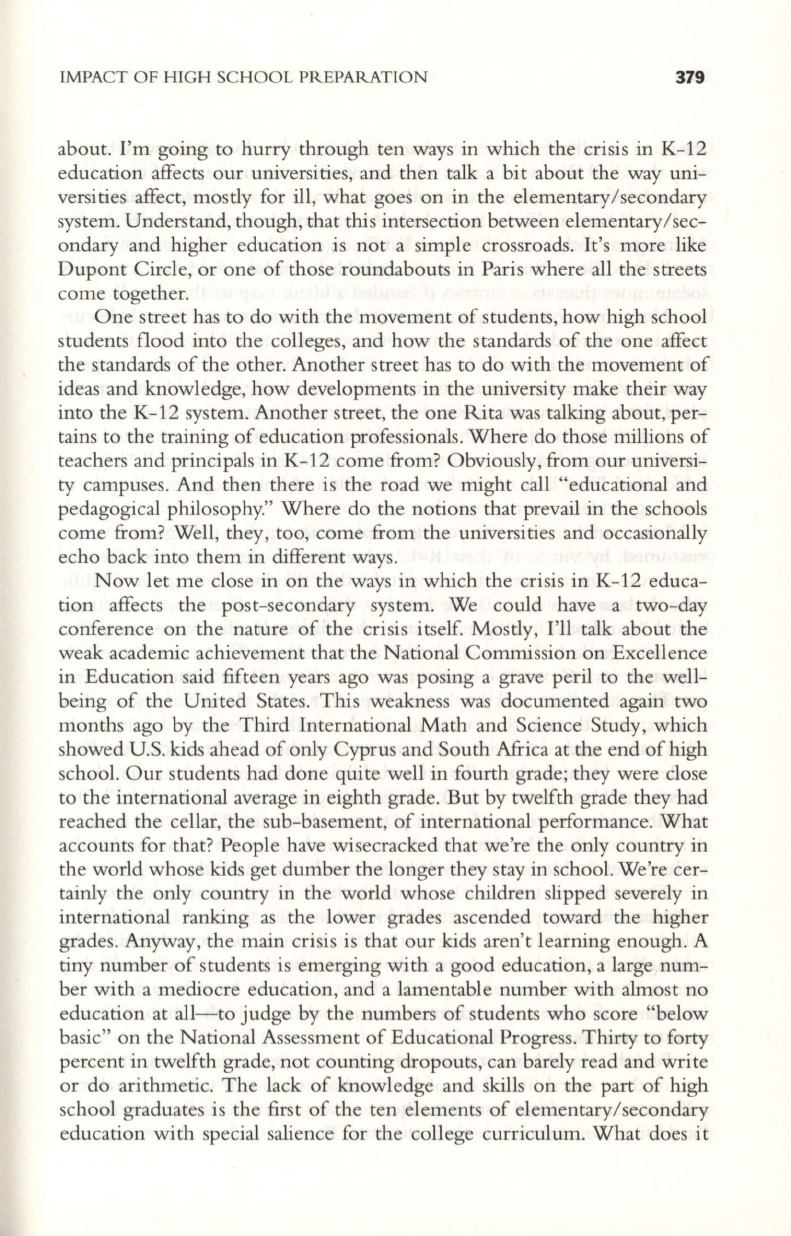
IMPACT OF HIGH SCHOOL PREPARATION
379
about. I'm going to hurry through ten ways in which the crisis in K-12
education affects our universities, and then talk a bit about the way uni–
versities affect, mostly for
ill,
what goes on in the elementary/ secondary
system. Understand, though, that this intersection between elementary/ sec–
ondary and higher education is not a simple crossroads. It's more like
Dupont Circle, or one of those roundabouts in Paris where all the streets
come together.
One street has to do with the movement of students, how high school
students flood into the colleges, and how the standards of the one affect
the standards of the other. Another street has to do with the movement of
ideas and knowledge, how developments in the university make their way
into the K-12 system. Another street, the one Rita was talking about, per–
tains to the training of education professionals. Where do those millions of
teachers and principals in K-12 come from? Obviously, from our universi–
ty campuses. And then there is the road we might call "educational and
pedagogical philosophy." Where do the notions that prevail in the schools
come from? Well, they, too, come from the universi ties and occasionally
echo back into them in different ways.
Now let me close in on the ways in which the crisis in K-12 educa–
tion affects the post-secondary system. We could have a two-day
conference on the nature of the crisis itself. Mostly, I'll talk about the
weak academic achievement that the National Commission on Excellence
in Education said fifteen years ago was posing a grave peril to the well–
being of the United States. This weakness was documented again two
months ago by the Third International Math and Science Study, which
showed U.S. kids ahead of only Cyprus and South Africa at the end of high
school. Our students had done quite well in fourth grade; they were close
to the international average in eighth grade. But by twelfth grade they had
reached the cellar, the sub-basement, of international performance. What
accounts for that? People have wisecracked that we're the only country in
the world whose kids get dumber the longer they stay in school. We're cer–
tainly the only country in the world whose children slipped severely in
international ranking as the lower grades ascended toward the higher
grades. Anyway, the main crisis is that our kids aren't learning enough. A
tiny number of students is emerging with a good education, a large num–
ber with a mediocre education, and a lamentable number with almost no
education at all-to judge by the numbers of students who score "below
basic" on the National Assessment of Educational Progress. Thirty to forty
percent in twelfth grade, not counting dropouts, can barely read and write
or do arithmetic. The lack of knowledge and skills on the part of high
school graduates is the first of the ten elements of elementary/ secondary
education with special salience for the college curriculum. What does it


